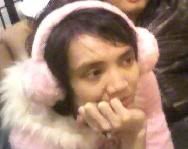 Mangajin was a classic magazine that used manga as a fun and effective way to learn Japanese. Published between 1990-97, it also included interesting features on various aspects of Japanese culture. It's now out of print, but back issues are still available from Wasabi Brothers. Your support might even help them in their efforts to revive one of the best magazines to come out of Japan.
Mangajin was a classic magazine that used manga as a fun and effective way to learn Japanese. Published between 1990-97, it also included interesting features on various aspects of Japanese culture. It's now out of print, but back issues are still available from Wasabi Brothers. Your support might even help them in their efforts to revive one of the best magazines to come out of Japan. Many manga carry full-color advertisements for muscle-building devices and pheromone sprays. As you might have guessed, most manga are geared toward shonen (young guys). But there are also shojo (young girl) manga. They deal mainly with science-fiction, sports and romance and tend to portray male characters as stereotypically as the guy's manga do with female characters. A popular girl's manga is Sailor Moon, which also became a successful TV show and several movies. Naturally, they're popular with girls but also with a certain number of boys and young men. This and the popularity of animated porn is, I'm afraid, beyond my understanding. Suffice to say that the world of manga and anime (animation) is huge in Japan and beyond and there are countless Web sites dedicated to it.
Manga come in two main forms: weekly, twice-monthly and monthly magazine style manga and paperback books, usually in a series. These series often spin off from the magazines and in turn are made into TV shows or movies. For some examples, see the sections on Animated movies and TV cartoons.
Shonen Magazine
One of the pioneers of the fat shukan manga (weeklies), along with Shonen Sunday, Shonen Magazine debuted in 1959 and is still one of the most popular boy's manga (shonen means young boy). With over 200 pages and a cover price of 230 yen, it seems like pretty good value. All the stories use kana (phonic) characters next to the kanji (Chinese characters), which makes them readable for the younger or less literate Japanese and useful for students of the language. As well as the manga stories and advertisements, the magazine has full-color photo spreads of a couple of teenage bimbos, usually in bikinis and with a contact address for fan-mail. The October 27th, 1999 issue (right) includes the mangas GTO (Great Teacher Onizuka), which has been made into a TV drama and a movie, and Psychometora EIJI, made into a TV psycho-drama starring heartthrob Matsuoka Masahiro. Other subjects include soccer, fishing and sushi, while with some of the manga it's hard to tell what exactly they're about.
The magazine is published by Kodansha, who also publish a variety of other magazines in six categories: General/Men; Women; Children; Literature/Arts; Comics for Men; Comics for Women.
Shukan Shonen Jump
Launched in 1968, Jump tried to do things differently from the start. In order to compete with the already successful Shonen Magazine and Shonen Sunday, Jump concentrated on hiring and hanging onto talented but as yet undiscovered cartoonists and keeping a close eye on what its readers wanted, through surveys and polls. This approach helped Jump become by far the biggest manga in Japan with sales as high as six million copies a week. Its most successful series have been spun off to create TV cartoons, movies and video games including Dragonball Z and Dragon Quest which have been hugely popular both in Japan and abroad. Other huge domestic hits include Kinnikuman (Muscle Man) and Slam Dunk, which capitalized on the NBA craze of the early and mid-90's.
The publisher of the manga, Shueisha has dozens of other publications, including Ultra Jump, Business Jump, Young Jump, Monthly Jump etc and women's manga like Margaret, Young You and Ribbon and magazines such as the Japanese editions of Cosmopolitan and Playboy.






Post a Comment